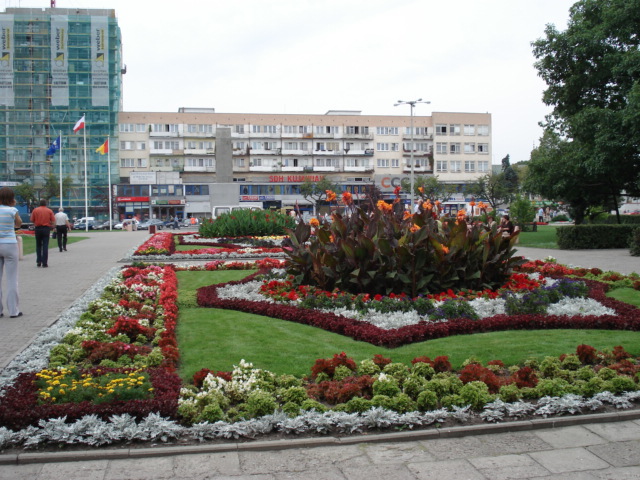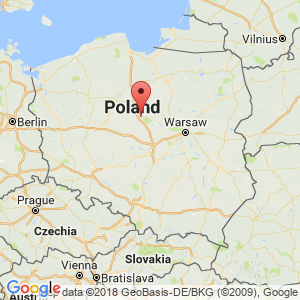Włocławek
(Short edition)

From Plac Wolności in Włocławek
Distance
Population
116.914 (2010)
Location and history
Włocławek is located in central Poland, on the Wisła River, in the Kuyavian-Pomeranian region (157 km northwest of Warsaw). The city is the center city for the district of the same name. The main road connection is the north-southbound highway # 1 from Gdańsk to Cieszyn. The direct rail link is the Warsaw-Kutno-Włocławek-Toruń-Gdańsk line. The nearest international airports are at Warsaw, Bydgoszcz and Łódź.
Ca. 500 years before our time, there was a settlement here. At the transition between the 10th and 11th years. There was a princely residence here, which over time expanded into a foundation-walled castle that was the seat of the bishops of Włocławek. The city gained market town rights in 1255. In the 1300s and 1400s, the city suffered greatly from attacks on the Crusader order and in the mid-1600s, under Swedish attacks. After Poland's 2nd division in 1793, the city was under Prussian rule. After 1815, Włocławek was part of the Polish Kingdom in personal union with Russia; from 1832 to 1916 the area was an integral part of the Russian Empire. During World War II and the German occupation, almost all Jewish residents (21% of the population) were killed, as were many other residents displaced, sent to forced labor, sent to concentration camp or executed – not least those belonging to the intelligentsia. After the war, Włocławek became known as an industrial city. The creation in 2008 of a local business development area with an industrial and technology park will support this development.
Tourist attractions
Selected attractions:
Franciscan Reformist Church and Monastery , Place Wolnosci no.6.
The building complex is Baroque (partially Gothic) and was built 1639-44. The church has been serving as a parish church since 1969. The interior of the buildings is kept in Baroque and Rococo style. The complex is surrounded by a wall with a gate from 1797.
Museum of Kujawy and Dobrzyń area , ul.Słowackiego 1a.
The building dates from 1927-30.
Church of Saint Vitale
The church from 1330 is in Gothic style. Until 1411 it served temporarily as a cathedral. In 1569 the building became a church for the priesthood seminary and has since functioned as such.
Domkirkebasilikaen , Plac Kopernika 7
This is a Gothic building from 1340-1411. A restoration was begun in 1890.
The residence of the prelate , ul.Kopernika 7,
is located right next to the cathedral. It is a ground walled building from 1801, built on top of a basement floor that is probably from the 16th century.
The dam
The dam across the river that dams Wisła and forms the large reservoir of water: Lake Włocławek was put into operation with a hydroelectric plant on 17 October 1970. The hydroelectric power station is the largest of this type in Poland. There were actually 8 water reservoirs of this kind planned on the lower part of the Wisła River, but due to lack of funds, only this was realized. Over time, this has resulted in a very large load, in the form of water pressure and bottom deposits, of the dam in Włocławek.
The black warehouse (Czarny spichrz), ul.Piwna 4
This is a two-storey log house plus a roof, built in the early 19th century. for magazine purposes; in 1980 the building was decorated for cultural purposes.
The former canon house (Kanonia), ul.Gdańska 8
The house was built in 1649 by canon Stanisław Orłowski, but later rebuilt several times; it is now furnished for museum purposes.
Bispegården (Bishop's Palace, Pałac Biskupi), ul.Gdańska
At the site of the first castle from the 10th to the 13th century. a foundation walled castle was erected using the walls of the original castle; the building was the main castle from the 14th century. and since the bishopric until the 18th century. In 1861 the castle was completely rebuilt into a classic residence. In 1925 rebuilt after a fire to serve as the seat of the curia and residence of the bishop.
The Church of John the Baptist . parish church
This is a 1538 Late Gothic church building with Renaissance and Baroque style extensions.
Surrounding Area
The area is marked partly by the Wisła River Valley and partly by the nearby landscape park.
Włocławek Lake. Between Płock and Włocławek, the river Włocławek runs through the river, built in 1970 by the construction of a dam at Włocławek. The purpose of the artificial lake is to reduce the risk of flooding, to generate energy through the Włocławek hydroelectric plant and to support tourism in the creation of tourist facilities in small towns along the lake shores.
Gostynin-Włocławek Landscape Park lies along the southern bank of the river, southeast of the city, and extends all the way to Plock. The park was established in 1979 and has extensive forests with rich wildlife and several beautiful small lakes. The river and the reservoir create all kinds of possibilities for fishing, swimming and any kind of water sports. In the forests you can take long walks and enjoy the nature and possibly take advantage of the opportunities for agrotourism (farm holidays) offered in the area.
Wieniec-Zdrój. Ca. 5 km west of the town is the small health resort Wieniec-Zdrój. The mineral springs here were discovered in 1907. In addition, there are local occurrences of peat with beneficial effects.
Accommodation
Other Internet sites and sources
Translated into English by Google Translate. Spangshus.dk accept no liability for any errors or omissions in translation.
Map

Rating
Search
Most used tags
churches (205) Castles (86) Monasteries (79) Town walls (74) Lakes (71) Town halls (67) Rivers (65) Castles1 (62) Mansions (55) Museums (51) Regional museums (38) Town gates (36) Abbey churches (35) Castle ruins (30) Cathedrals (26) Forests (25) Health resorts (24) Water sports (23) Mounds (23) National parks (22)Click for all tags
Denne side er også tilgængelig på dansk. This page and contents is (c) Copyright 2018- www.spangshus.dk. Based on Inviator software by ISCA Software